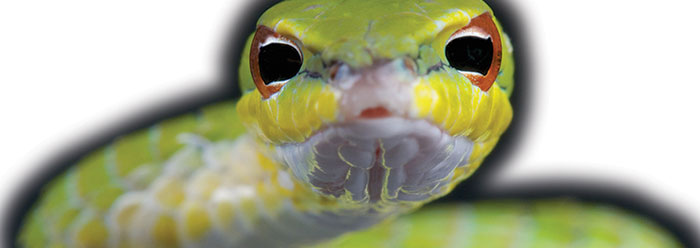Unbelievers and Christians alike often ask, “How could a good god make creatures with toxic venom?” According to the Bible, God originally created the world free of death, disease, and violence. When Adam and Eve rebelled, the entire creation was subjected to a curse that resulted, among other things, in venomous snakes, stinging arthropods, and disease-causing pathogens.
A major question facing creation biologists is how this curse has affected the genomes of modern creatures that defy the idea of a perfect creation, such as poisonous snakes. A highly plausible, biblical, and scientific model is now emerging and gaining validity thanks to recent snake studies. This model is based on information corruption in the genome, sometimes referred to as genetic entropy. Support for this idea is based on the fact that genes and their regulatory sequences have become corrupted through genome degradation—resulting in traits inconsistent with the original intent of God’s creation.
Evolutionists originally believed new snake venom genes came about by the duplication of genes that have other important tasks in the snake’s body. However, in a recent study, scientists found that duplication of regions containing genes rarely produces anything good.1 Instead, they took a different approach and looked for other explanations of snake venom outside the standard evolutionary framework. The researchers analyzed and compared gene expression in venom glands and other body tissues in a wide variety of venomous and non-venomous snakes. They even included tissues from the gecko, a little lizard.
Amazingly, the researchers claimed, “We find the hypothesis that snake venom evolves through the duplication of physiological or body genes and subsequent recruitment into the venom gland to be unsupported by the available data,” and “indeed for a large number of the gene families claimed to have undergone recruitment [used for other purposes after being duplicated] we find evidence of a diverse tissue expression pattern, including the salivary gland of nonvenomous reptiles.”1 The key importance of this discovery is that venom genes are not the products of hypothetical evolutionary processes (i.e., gene duplication). Instead, the data show they are important DNA sequences that serve other purposes in a wide variety of reptile tissues. We see the same thing in the human body—the same genes are expressed in a variety of different tissues.
In another study, researchers utilized a comprehensive set of 24 reptilian venom-gene families that they compared to the genome of the Burmese python, a non-venomous snake.2 They also analyzed gene expression datasets from 12 different python tissues. This research further vindicated the emerging genetic model revealed by the previous study, namely that the genes that encode venom proteins are not specific to venom glands but are actually expressed in many different tissues throughout the snake’s body. The difference in the venom glands is that some genes are expressed in much greater quantities—resulting in greater amounts of venom proteins. This dosage-dependent phenomenon explains the toxic properties of venom. The purpose of these proteins produced at lower concentrations in other bodily tissues has not been fully investigated and is not well understood.
Interestingly, the first study also showed that the increased expression of venom genes was probably due to the corruption of regulatory DNA sequences that act like switches outside the gene itself.1 These specialized genetic sequences tell the gene what tissues to function in and how much product to make. Therefore, mutations in these regions cause genes to become misregulated, resulting in elevated levels of proteins in venom glands for some snake species. Creation scientists would predict this type of scenario resulting from the corruption of genetic information associated with the curse and the degradation of the genome over time.
Both studies indicate that venom genes serve other non-venomous purposes in a variety of reptile tissues. The toxic amounts of venom proteins in modern venomous snakes are likely due to the genomic degradation of regulatory switches that alter a gene’s expression patterns. Research has shown that genomes have undergone a process of information corruption initiated during the Adamic curse, not an upward evolutionary improvement.
References
- Hargreaves, A. D. et al. 2014. Restriction and recruitment – gene duplication and the origin and evolution of snake venom toxins. Genome Biology and Evolution. 6 (8): 2088-2095.
- Reyes-Velasco, J. et al. 2015. Expression of venom gene homologs in diverse python tissues suggests a new model for the evolution of snake venom. Molecular Biology and Evolution. 32 (1): 173-183.
* Dr. Tomkins is Research Associate at the Institute for Creation Research and received his Ph.D. in genetics from Clemson University.




